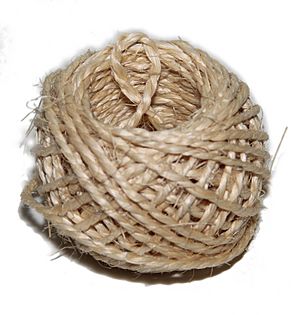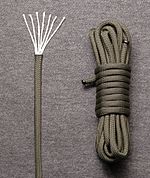Twine facts for kids

Twine is a strong, thin cord made by twisting together two or more smaller strands. It is like a thicker version of string. You can find twine made from natural materials like cotton, sisal, jute, and hemp. It can also be made from man-made materials called synthetic fibres. Twine comes in many colors, and some types are even waxed. It's super useful for many different tasks, much like duct tape!
Contents
What is Twine Used For?
Twine is used in many ways, from fun projects to big industries.
Twine in Arts and Crafts
In arts and crafts, twine is very popular. People use it for:
- Knitting
- Crocheting
- Making jewellery
- Creating decorations
Twine in Industries
Businesses also use twine a lot. Some common uses include:
- In upholstery, which is covering furniture with fabric.
- Making rugs.
- In agriculture, like tying up hay bales.
- In the cotton and textile industries.
- In making cartons and packaging.
The Long History of Twine
Twine has been around for a very long time, even before recorded history!
Early Uses of Twine
The first signs of twine go back about 32,000 years. Ancient people used wild flax fibers to make twine. They used it for:
These early Hunter-gatherers were skilled at turning flax into strong cords.
Discoveries by Archaeologists
Archaeologists have found flax fiber cords in a cave in Western Asia. These cords are between 32,000 and 26,000 years old! In France, at a place called Lascaux, scientists found parts of a "two-ply rope" that was about 7 mm thick. This rope is about 15,000 years old.
Hemp Twine Through Time
Hemp twine started being used around 8,000 BCE. By 1,000 BCE, most civilizations were using hemp rope and twine. For example, from 500 BCE to 1900 AD, almost all the rope and twine on sailing ships was made from hemp. The famous ship USS Constitution used hemp for its rigging lines. Sailors also used hemp cordage for their bags and other items.
Twine Making in America
In the 1630s, people in Boston started making cordage from hemp. Soon, there were many places called ropewalks in Boston. These were long buildings where workers twisted hemp twine into strong ropes.
Related pages
Images for kids
See also
 In Spanish: Cordel (textil) para niños
In Spanish: Cordel (textil) para niños




